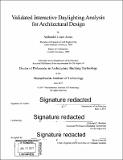| dc.contributor.advisor | Christoph F. Reinhart. | en_US |
| dc.contributor.author | Jones, Nathaniel Louis | en_US |
| dc.contributor.other | Massachusetts Institute of Technology. Department of Architecture. | en_US |
| dc.date.accessioned | 2017-09-15T15:35:13Z | |
| dc.date.available | 2017-09-15T15:35:13Z | |
| dc.date.copyright | 2017 | en_US |
| dc.date.issued | 2017 | en_US |
| dc.identifier.uri | http://hdl.handle.net/1721.1/111461 | |
| dc.description | Thesis: Ph. D. in Building Technology, Massachusetts Institute of Technology, Department of Architecture, 2017. | en_US |
| dc.description | Cataloged from PDF version of thesis. | en_US |
| dc.description | Includes bibliographical references (pages 139-152). | en_US |
| dc.description.abstract | The conventional approach to predicting interior illumination and visual discomfort in buildings is to run a ray tracing simulation with high accuracy settings, wait while the simulation processes, and repeat as necessary with modifications to the scene and settings. This workflow lacks interactivity and usually occurs late in the design process to validate a completed design, if at all. For architecture to benefit from daylight as a practical, glare-free alternative to electric lighting, daylighting simulation and visual discomfort predictions must be available in real time during design. This thesis describes three innovations towards this goal: development of a parallel ray-tracing engine, validation against high dynamic range (HDR) photography and annual simulations, and human subject tests with interactive progressive rendering. Lighting simulation can be sped up more than an order of magnitude by running it in parallel on readily available graphics processing units (GPUs). Accelerad is a GPU-accelerated version of RADIANCE synthetic imaging software for global illumination simulation developed by the author, introducing a novel method for parallel multiple-bounce irradiance caching. In validation studies comparing simulated and measured luminance and visual discomfort, Accelerad achieves similar accuracy to RADIANCE at a speedup of 16 to 44 times. Applied to annual simulation methods to calculate climate based daylighting metrics such as daylight autonomy and annual sun exposure, Accelerad is 10 times faster than DAYSIM and 25 times faster than the five-phase method. Additionally, a progressive path tracing option is explored that calculates glare probability in seconds and enables interactive visual discomfort simulation. By providing accurate lighting simulation results to designers in real time, this information is expected to inform the design process in ways not previously possible. In human subject tests, the availability of realtime feedback was associated with increased exploration of the design space, higher confidence in proposed designs, higher satisfaction with the design task, and better performing designs with respect to daylight autonomy and daylight glare probability. This supports the theory that system response time affects users' cognitive states and suggests that designers will be more likely to adopt building performance simulation tools if they produce reliable results at interactive speeds. | en_US |
| dc.description.statementofresponsibility | by Nathaniel Louis Jones. | en_US |
| dc.format.extent | 154 pages | en_US |
| dc.language.iso | eng | en_US |
| dc.publisher | Massachusetts Institute of Technology | en_US |
| dc.rights | MIT theses are protected by copyright. They may be viewed, downloaded, or printed from this source but further reproduction or distribution in any format is prohibited without written permission. | en_US |
| dc.rights.uri | http://dspace.mit.edu/handle/1721.1/7582 | en_US |
| dc.subject | Architecture. | en_US |
| dc.title | Validated interactive daylighting analysis for architectural design | en_US |
| dc.type | Thesis | en_US |
| dc.description.degree | Ph. D. in Building Technology | en_US |
| dc.contributor.department | Massachusetts Institute of Technology. Department of Architecture | |
| dc.identifier.oclc | 1003321783 | en_US |
